Double cleansing may sound like a lot of effort, but it can actually make your skincare routine much easier. Cleansing twice instead of once can give your skin the most thorough cleaning imaginable, without compromising its barrier functions. It is somehow gentler yet more effective than cleansing once, especially for those who wear a full face of makeup or a lot of sunscreen.
The wonderful thing is that you don’t have to have a multi-step K-beauty skin care routine or the best face cleansers to benefit from adding the double cleansing method to your life. If you’re intrigued by the notion of adding double cleansing to your beauty routine I’ve prepared a thorough guide to get you started.
I’ll explain in detail what double cleansing is and how it started, and go over all of its benefits. I address any concerns you might have about over-washing, and then delve into the different skin types and how they can benefit from the double cleansing method. To finish things off, I’ll explain exactly when you should double cleanse and how!
In this article:
- What Is Double Cleansing?
- All the Benefits of Double Cleansing
- Can You Over-Wash Your Face When Double Cleansing?
- Double Cleansing Based on Skin Type and Concerns
- How to Double Cleanse
What Is Double Cleansing?
The most memorable thing the Korean beauty trend brought to us was skincare routines with multiple steps. One of those was an additional cleansing step.
In a typical routine, you would cleanse your face once with a foaming cleanser (or maybe a milky cleanser if you’re fancy), and often you would end up with a fair bit of makeup residue on your skin, even if you don’t notice. Alternatively, you might find yourself harshly scrubbing and wiping your face in order to get rid of everything.
In a double cleansing routine, you would first cleanse with a cleanser that can really break down the various debris and impurities that sit on the surface of the skin. The first cleanser is usually oil-based, which allows it to dissolve any other oil-based impurities including your own sebum as well as sunscreen and makeup.
Some people use micellar water or makeup remover for their first cleanser, especially if they’re averse to using oil-based products. Though double cleansing is associated with K-beauty, oil cleansers first became popular in Japan, and even to this day the most popular oil cleansers on the market are manufactured by Japanese beauty brands like Shiseido and DHC.
For a second step you would use a gentle but water-based cleanser that will help give the skin a final clean and get rid of any residue the first cleanser left behind while also eliminating water-based impurities. It’s also great for preparing the skin for actives like glycolic acid, which cannot penetrate the skin through oil. The second cleanser is normally a gel or foam cleanser, though cream cleansers and milk cleansers are also popular.
Though it may seem like a new beauty trend, the double cleansing method is not very different from the practice of wiping the face with makeup remover before cleansing it with a face wash.

All the Benefits of Double Cleansing
So what are the benefits you’ll get double cleansing your skin?
• Thoroughly Cleansing
By cleaning your skin twice, you end up cleaning it deeper and better. Each cleanser is formulated differently so that it targets impurities in a different way, so the double cleansing method ends up cleaning the skin much more thoroughly than a single cleanser can.
• Gentle
The double cleansing method can be much gentler on the skin than a single cleanse, as long as you choose gentle cleansers for step one and step two. When only using one cleanser, we often end up scrubbing our skin too harshly and for too long, and the ingredients needed to thoroughly break everything down in one go can often be drying and irritating. By splitting cleansing into two steps, each cleanser can be gentle and the overall effect on the skin can be soothing.
• Customizable
No matter your skin type, you can adjust the types of cleansers you use in a double cleansing routine in order to give maximum benefits to your skin. This routine can be more or less moisturizing, soothing, pore-clearing and more, all depending on your needs and desires. I explain exactly how you can customize your double cleansing routine in the next section.
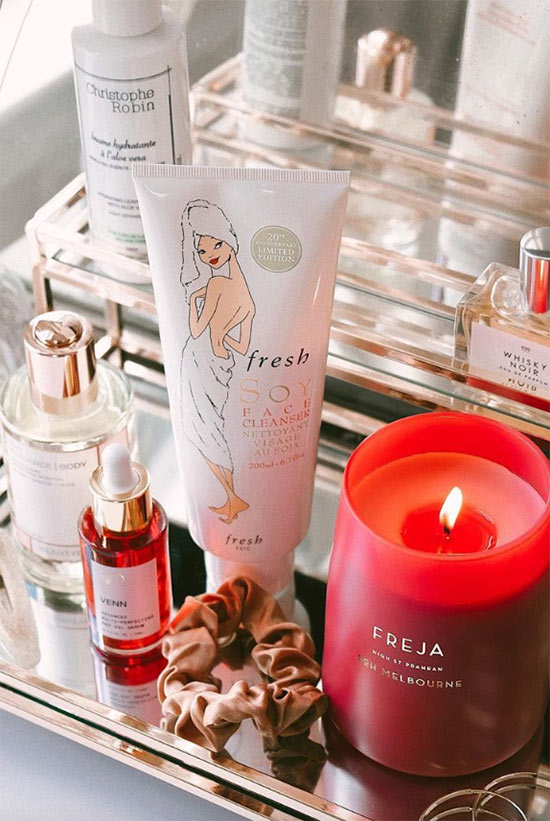
Can You Over-Wash Your Face When Double Cleansing?
You might be surprised to learn that rather than risking over-washing, double cleansing does the exact opposite! By relying on an oil-based cleanser to break down oils and a water-based cleanser to break down water-soluble impurities, the double cleansing method turns your cleaning routine into a much gentler one.
Double Cleansing Based on Skin Type and Concerns
Double cleansing is great for every skin type, and it’s a definite must if you wear makeup on a daily basis or if your sunscreen habits are on point. Depending on your skin type and specific skin concerns, you will probably want to use a different first cleanser and second cleanser.
Double Cleansing for Dry Skin
Dry skin refers to a skin type that doesn’t produce a lot of facial oils (i.e. sebum), and is usually accompanied by smaller pores especially when one is younger. Those with dry skin should use every step in their skincare routine as a change to infuse their skin with both hydrators and emollients, including their cleansing steps.
Double cleansing is a great way to ensure that all traces of debris are totally gone from the skin without stripping the skin of its much-needed natural oils or drying it out.
First Cleanser: A rich oil or balm cleanser is the best choice, since it will totally dissolve makeup and sunscreen while also infusing the skin with nutrients and emollient oils. You can choose a dedicated oil cleanser with surfactants that can be rinsed away with water, or you can opt for just a regular oil or oil blend that can be removed with a cloth. You won’t be able to rinse it away with water, but a second cleanser will get rid of any traces of it.
Second Cleanser: When you have dry skin, the gentler your second cleanser, the better. Not only should you stick to a sulfate-free cleanser, but it’s better to choose a cleanser that won’t foam up or lather too much as even that can be too drying. A milk or mousse cleanser that contains mild surfactants will be best, but an extremely gentle cream-gel or foam cleanser may also work.
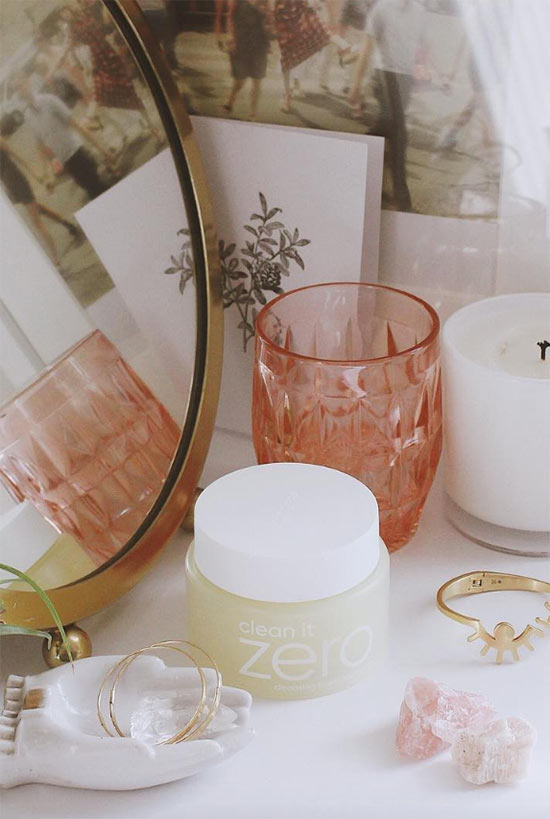
Double Cleansing for Oily Skin
Oily skin produces a lot of sebum throughout the day, so the skin can become shiny easily. Those with oily skin often have larger pores, and they are more acne-prone. Double cleansing is a great way to ensure that there is no pore-clogging debris left on your skin, especially if you wear heavy makeup or sunscreen.
First Cleanser: When you have oily skin, you may shy away from oil-based cleansers, but that’s actually the wrong instinct. Oil cleansers are actually great for oily skin because they can break down everything including oils and can deep clean the pores. In fact, one of the best ways of removing little sebum plugs from the pores and minimizing their appearance relies on an oil cleanser.
It’s important to choose an oil cleanser with oils that won’t clog your pores. You will want it to contain some surfactants so it will be easy to rinse away with water. If you are totally averse to using oil-based products, however, you can choose micellar water for your first cleanse instead.
Second Cleanser: Your second cleanser should be a gel-based one, as it will do a better job of removing oils from the skin. As always, avoid anything soap-based or sulfate-based, and instead look for a gentle cleanser with a low pH.
Double Cleansing for Combination and Normal Skin
When you have normal and combination skin you experience some oil production, usually around the T-zone, although you may also get a little bit dry in the cheek area sometimes. Since double cleansing works for all skin types, it will certainly suit your skin as well!
First Cleanser: The best cleanser when you have normal or combination skin is an oil-based cleanser that emulsifies and rinses clean with water. Most of the cleansers I’ve recommended for a first cleanse will probably suit your skin beautifully.
Second Cleanser: The texture of the second cleanser probably matters more with your skin. You will need a balanced cleanser that is neither too mild nor too stripping. The same requirements I always repeat apply here as well – it should be slightly acidic and free of harsh surfactants.
Mild gels and creamy cleansers that lather up are ideal because they don’t leave a residue but are also not dehydrating. If your skin gets oilier or drier depending on the season, you can also change up your second cleanser accordingly.
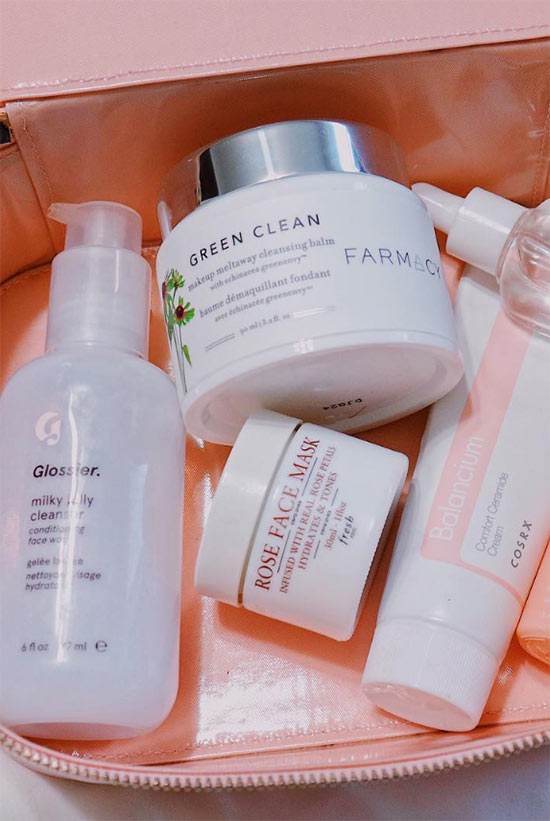
Double Cleansing for Clogged Pores and Acne
The double cleansing method is exceptional for clearing clogged pores without aggravating active breakouts. This is because it is mild enough not to worsen the inflammation of breakouts, but it cleanses thoroughly and does a great job of dissolving any impurities that clog up the pores.
First Cleanser: Oil cleansers are surprisingly amazing for deep cleaning the pores. This is because they are better at penetrating through layers of sebum, and they create a slippery environment that allows impurities to just slide out of the pores. In the long term, this can help minimize the pores since it’s also a gentle enough process that doesn’t stretch them out by irritating them.
When combined with a clay mask and salicylic acid, the first cleanse is actually great for removing blackheads and sebaceous filaments. It’s useful to choose oil-based cleanser with non-comedogenic oils like grape seed oil, sunflower oil, safflower oil, or mineral oil. However, since the cleanser doesn’t sit on the skin for too long, even some comedogenic oils are not a big deal, especially if they show up towards the end of the ingredient list.
Second Cleanser: The second cleanser you choose will depend on your skin type. Breakouts and clogged pores usually come hand in hand with oily skin, so you will likely prefer a gel or foam cleanser.
However, even those with dry skin can experience breakouts, so you can choose a creamier second cleanser. Another great choice is a cleanser that contains a bit of a chemical exfoliant or with anti-inflammatories, as those are great for reducing breakouts.
However, it’s worth noting that your leave-on products are much more important in this instant. Be aware that cleansers with a high pH will make your skin more breakout-prone by allowing bacteria to proliferate, so choose an acidic cleanser.
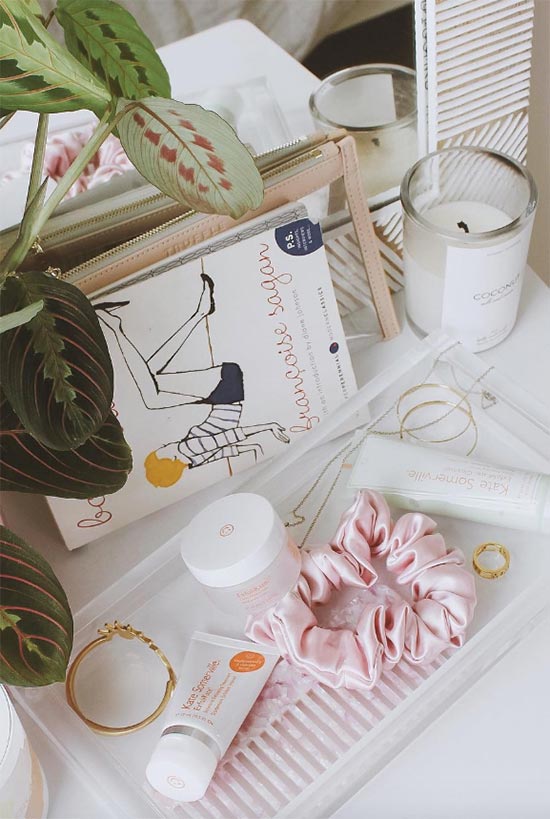
Double Cleansing for Sensitive Skin
Sensitive skin gets red and irritated very easily. It’s more of a concern than a skin type, since those with sensitive skin can also be oily, dry, normal, or combination when it comes to their skin’s sebum production levels.
Double cleansing relies on using two very gentle types of cleansers, rather than a single harsh cleanser, which makes it ideal for those with sensitive skin. This is because it minimizes the amount of tugging and rubbing that can exacerbate sensitivity and cause irritation. It also makes it easier to avoid very harsh detergents that might not work as well to remove makeup or sunscreen on their own.
First Cleanser: The oil and balm cleansers recommended for a first cleanse are almost universally appropriate for those with sensitive skin, since they usually rely on oils rather than detergents to break things down. Many people with easily-irritated skin are particularly sensitive to fragrances and essential oils, so you might want to look out for fragrance-free cleansers.
Micellar water is not ideal since it doesn’t glide quite as gently over the skin. If you do decide you prefer to use micellar water it’s actually better in a double cleanse since your second cleanser will deal with any residue that would otherwise be left on your skin.
Second Cleanser: As with the first cleanser, you also want your second cleanser to be gentle and free of fragrances. It’s good to look for a creamier, sulfate-free option with a low pH. Cleansers described as “mild” with short ingredient lists are best, and you can choose the particular texture based on the amount of oil your skin produces.
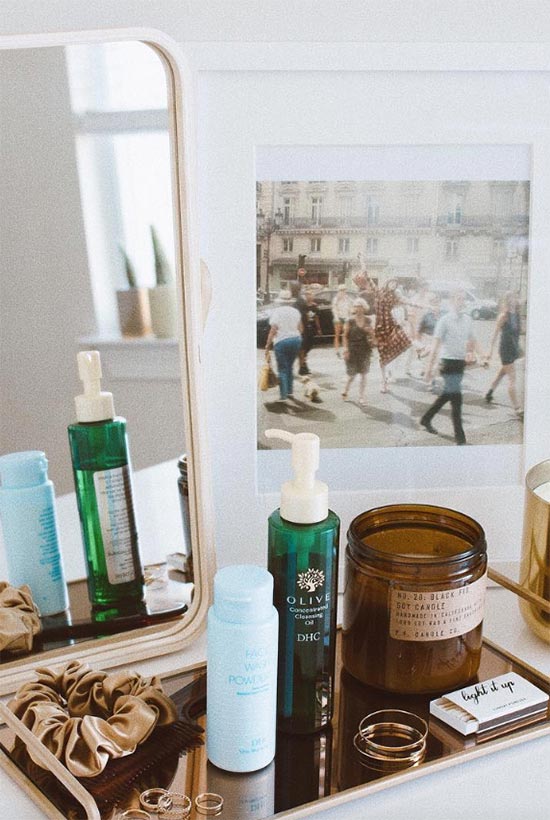
How to Double Cleanse
Once you learn how to double cleanse, it becomes an easy and intuitive process. However, it’s important to first learn the correct way first, as well as why things are done the way they’re done.
Not everyone has to double cleanse every night, and certainly not twice a day. If you’ve been following my writing, you know that I usually advocate against cleansing the skin at all in the mornings, and if you must then to only do so once with a gentle cleanser – your second cleanser could absolutely do the trick.
Double cleansing should be reserved for evenings, and when thorough cleansing is needed. A single cleanse will probably be enough for days when you’ve worn minimal or no makeup and haven’t needed to apply your sunscreen more than once.
However, if you’ve applied additional layers of sunscreen throughout the day or if you’ve worn a full face of heavy makeup, then a single cleanser will probably not do the trick. If it does, it’s very possible that it’s a little too harsh for your skin. That is why the double cleansing method is so wonderful.
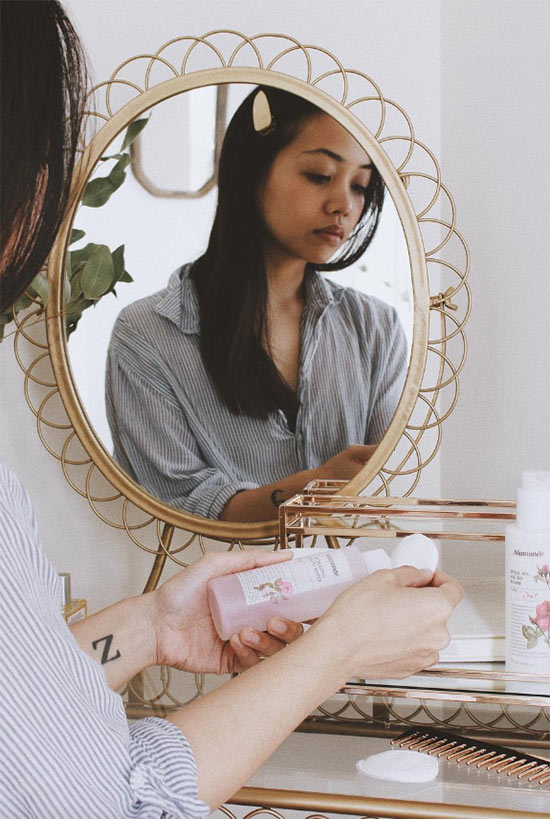
How to Do the First Step with Oil or Balm Cleanser
- Before you start your double cleansing process, wash your hands first. You don’t want to touch your face with dirty hands, after all.
- To start off, your face should be totally dry, since water will impede the ability of oil and balm cleansers to clean thoroughly.
- In the palm of your hand dispense about a quarter-sized amount of cleanser.
- Massage it slightly in between two hands (especially if it’s a balm cleanser), and then begin rubbing it over your face in circular, upward motions.
- Massage the cleanser in using very little pressure. Continue to massage until all sunscreen and makeup have been dissolved into it. This will usually take between 30 seconds to 2 minutes, depending on the amount of makeup you wore.
- Use your ring finger when using the cleanser to dissolve eye makeup in order to avoid stressing or damaging the sensitive eye area.
- Once your makeup has totally broken down, add a bit of water to emulsify your cleanser.
- Once it has turned cloudy or milky in color, rinse it off with water or use a damp face cloth to remove it.
- If your oil or balm cleanser is free of detergents (meaning that it cannot be rinsed away with water), then wipe it off with a soft face cloth, paper towel, or cotton pads.
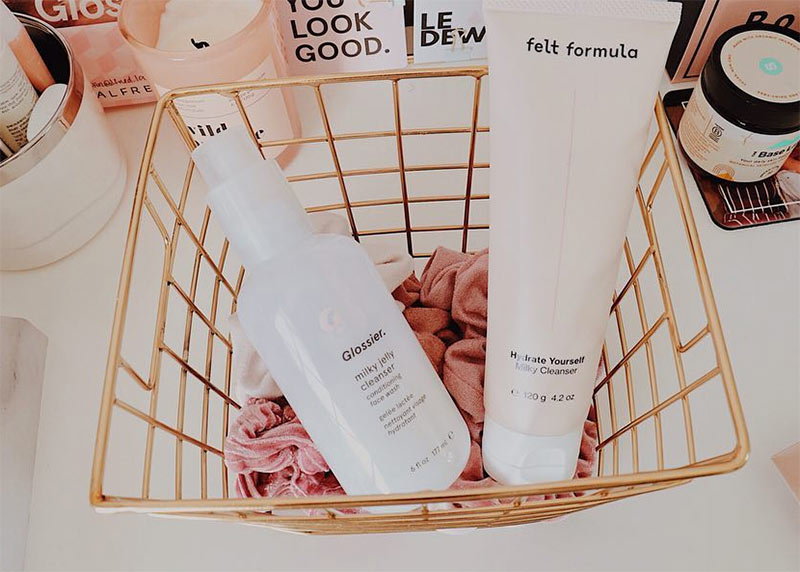
How to Do the First Step with Micellar Water
- To start, saturate a cotton pad with micellar water.
- Using upward and outward circular motions, wipe the cotton pad over your face.
- When it seems like the cotton pad is totally covered in makeup, flip it over and continue wiping with the other side.
- If one cotton pad is not enough to totally cleanse your face, you might have to saturate a new one with micellar water.
- To remove eye makeup, hold the cotton pad over your eye for a few moments, and then wipe gently downwards. You may have to repeat this a few times.
- To remove makeup from under the eyes, look upwards while wiping the cotton pad from the inner corner of the eye outwards. This will help you get as close to the lash line as possible.
- Once your entire face is clean, you can splash it with water to remove any micellar water residue.

How to Do the Second Step
- Splash your face with a bit of water to make sure both it and your hands are adequately damp for the cleanser to suds up.
- Dispense a pea-sized amount of your second cleanser into the palm of your hand, and then rub them together.
- In gentle, circular motions give your face a massage with the cleanser. Work your way outward and upward.
- Some sources recommend massaging the face with cleanser for at least a minute, but I believe 15-30 seconds are enough, especially for those who have sensitive skin.
- This is also your chance to use a cleansing tool like the Foreo or Clarisonic, if you’re into that.
- Once you’ve covered your entire face, rinse off the cleanse with a splash of cool or lukewarm water. You can also do this in the shower.
- To ensure all cleanser residue is totally gone, either splash your face multiple times or use a gentle, damp face cloth to remove any excess product.
- Finish things off with the rest of your nighttime skin care routine, which should consist of a moisturizer at the very least.

Photos via @katepurk, Instagram





